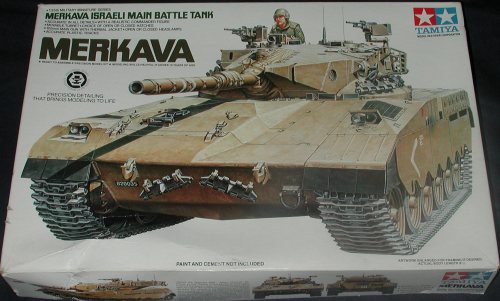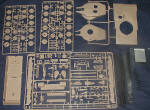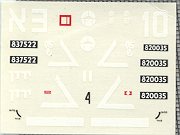
| KIT: | Tamiya 1/35 Merkava MBT |
| KIT #: | 3627A (also 35127) |
| PRICE: | $26.00 MSRP |
| DECALS: | Two options |
| REVIEWER: | Scott Van Aken |
| NOTES: |

| HISTORY |
The Merkava tank has been designed in accordance with experience gained from IDF armored battles in all Israel's wars since the Sinai Campaign (1956).
The Merkava Mk-1 is unique in its basic concept, common to all generations of the Merkava, according to which armor and survivability of the tank are its basic features. The tank's protection is based on all-round spaced ballistic armor, and deployment of the tank systems around the crew, thus utilizing basic elements and systems of the tank to protect the crew and ammunition, in addition to their specific functions. The most striking example of this concept is placement of the power pack (engine and transmission) at the front of the tank.
Other factors
contributing to the Merkava's survivability are:
- Low profile when in firing position
- Elimination of flammable materials from the crew compartments
- Storage of main gun ammunition under the turret ring, well to the rear of
the
hull, in heat-resistant containers
The Merkava Mk-I tank participated with a high degree of success in the 1982 war in Lebanon. Its production continued up to 1983, when the IDF Armor Corps began to receive the Merkava Mk-2 tank.
Lessons learned from the
operation of the Mk-1 tanks were applied to the Mk-2 tanks, mainly in the
following: - Improved mobility
- Improved fire control system
- Improved special armor
- Internal 60-mm mortar
The production of Mk-2 tanks continued until the end of 1989, at which time MK-3 tanks started to come off the production line. The MK-3 has since stopped production and the MK-4 is now being produced. Both of these later tanks are beyond the scope of this kit as I think this is a MK-1 version.
| THE KIT |
 Tamiya
is generally considered to be the king of armor kit makers. Their
reputation for not only producing what is wanted but also of doing an
outstanding job of things has kept them at the forefront of things that
crawl on the ground!
Tamiya
is generally considered to be the king of armor kit makers. Their
reputation for not only producing what is wanted but also of doing an
outstanding job of things has kept them at the forefront of things that
crawl on the ground!
This particular kit is molded in a nice tan plastic and the detail level on the parts is outstanding, even for a kit from 1984 (that is 20 years ago,folks). There are no sink areas, flash or ejector pin marks in places where it will be seen. The kit offers those 'rubber band' style of tracks that some abhor and others find just fine, especially if one doesn't want to do a lot of individual track links. The kit also includes a piece of screen mesh for use around vents and such.
In terms of options, I only found the
usual ones of open hatches, swiveling turret and machine gun. The kit
includes enough 'stuff' to pack around the turret to make thins look
properly busy. Like many early Tamiya kits, this one has various slots on
the bottom of the hull where the motorized bits go so most modelers will
have to fill that stuff in. There is o nly
one figure, and that is the tank commander, standing in the turret. This
kit also includes polycaps for the road wheels and drive sprockets.
nly
one figure, and that is the tank commander, standing in the turret. This
kit also includes polycaps for the road wheels and drive sprockets.
Instructions are excellent, providing clear drawings and little subassembly sections to help get things properly in place. As is still done today, only Tamiya paints are called out. There are markings for two tanks, both in desert sand color. Actually, I don't think the Israelis use any other shade. The only difference between the two are the decals, which probably mean something to most tank builders, but mean nothing to me. The decal sheet is well printed, but typical of Japanese decals of the period, are thick and the white is actually ivory.
| CONCLUSIONS |
I'd have to say that about half the armor/military vehicle kits I've built have been Tamiya. They have all been very good builds with minimal problems and I'm sure that this one will be no different.
| REFERENCES |
Thanks to http://www.israeli-weapons.com for the background info.
Review kit courtesy of your editor.
If you would like your product reviewed fairly and quickly by a site that has over 250,000 visitors a month, please contact me or see other details in the Note to Contributors.